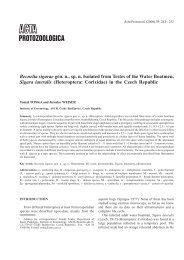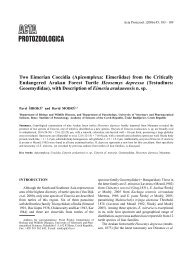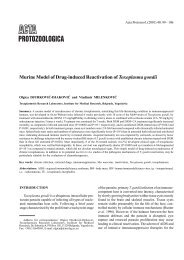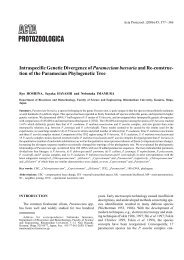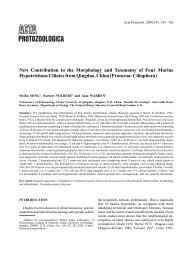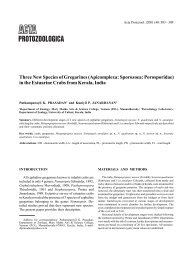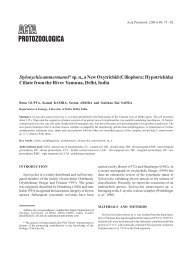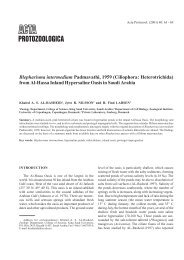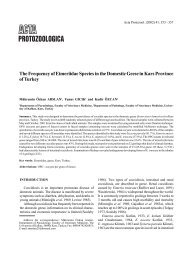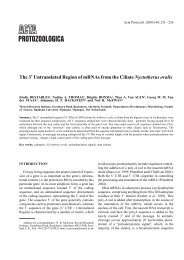Light Regulation of Protein Phosphorylation in Blepharisma japonicum
Light Regulation of Protein Phosphorylation in Blepharisma japonicum
Light Regulation of Protein Phosphorylation in Blepharisma japonicum
You also want an ePaper? Increase the reach of your titles
YUMPU automatically turns print PDFs into web optimized ePapers that Google loves.
312 H. Fabczak et al.<br />
Song 1997b). It <strong>in</strong>volves, as is the case <strong>in</strong> <strong>in</strong>vertebrate or<br />
vertebrate photoreceptor cells (Rayer et al. 1990), cGMP<br />
and <strong>in</strong>ositol trisphosphate as the possible second<br />
messengers (Fabczak H. et al. 1993, 1998, 1999;<br />
Fabczak H. 2000b).<br />
One <strong>of</strong> the most important mechanisms <strong>in</strong> the regulation<br />
<strong>of</strong> cellular metabolism or cell function is the<br />
process <strong>of</strong> prote<strong>in</strong> phosphorylation (Greengard 1978,<br />
Cohen 1982, Bünemann and Hosey 1999, Dickman and<br />
Yarden 1999, Graves and Krebs 1999). In the photoreceptor<br />
rod <strong>of</strong> vertebrate ret<strong>in</strong>a, there is evidence that<br />
phosphorylated prote<strong>in</strong>s may participate <strong>in</strong> the regulation<br />
<strong>of</strong> visual function. Of particular relevance are prote<strong>in</strong>s<br />
that exhibit light-dependent changes <strong>in</strong> the extent <strong>of</strong> their<br />
phosphorylation (Polans et al. 1979, Hermol<strong>in</strong> et al.<br />
1982, Lee et al. 1984, Hamm 1990). In the present study<br />
us<strong>in</strong>g immunological and densitometer methods, we demonstrate<br />
that prote<strong>in</strong> phosphorylation or dephosphorylation<br />
occurs <strong>in</strong> the ciliate when light is applied. These<br />
observations <strong>in</strong>dicate that the light-dependent processes<br />
<strong>of</strong> prote<strong>in</strong> phosphorylation may be <strong>in</strong>volved <strong>in</strong> the control<br />
<strong>of</strong> the photophobic behavior <strong>of</strong> <strong>Blepharisma</strong> <strong>japonicum</strong>.<br />
MATERIALS AND METHODS<br />
Cell culture<br />
Cells <strong>of</strong> <strong>Blepharisma</strong> <strong>japonicum</strong> were grown <strong>in</strong> 100 ml glass<br />
vessels conta<strong>in</strong><strong>in</strong>g Pr<strong>in</strong>gsheim solution (pH 7.0) at room temperature<br />
<strong>in</strong> darkness (Fabczak H. et al. 1993). The cells were fed with axenically<br />
cultured cells <strong>of</strong> Tetrahymena pyriformis. Prior to experiments,<br />
the cells were starved for at least 24 h before the organisms were<br />
collected, washed <strong>in</strong> an excess <strong>of</strong> fresh culture medium and subsequently<br />
used for assays after a further 12 h <strong>in</strong>cubation <strong>in</strong> fresh culture<br />
medium <strong>in</strong> darkness.<br />
Cell stimulation<br />
Before each experiment, 200 µl samples <strong>of</strong> dark-adapted cells<br />
were first left at rest for about 10 m<strong>in</strong> to avoid mechanical disturbances.<br />
They were subsequently exposed to light or ionic stimulation.<br />
The cell samples were illum<strong>in</strong>ated for 2 s with light afforded by<br />
a 150 W fiberoptic light source (MLW, Germany) equipped with an<br />
electromagnetic programmable shutter (model 22-841, Eal<strong>in</strong>g Electro-<br />
Optics, England). Ionic stimulation was performed by cell <strong>in</strong>cubation<br />
for 2 s <strong>in</strong> external 4 mM K + solution prepared by gentle addition <strong>of</strong><br />
the proper amount 0.1 M KCl to the cell suspension.<br />
Immunoblott<strong>in</strong>g assay<br />
In order to quantify prote<strong>in</strong> phosphorylation levels, samples <strong>of</strong><br />
control (dark-adapted) cells and cells follow<strong>in</strong>g treatment with light<br />
or potassium ions were immediately mixed after exposure with sample<br />
buffer conta<strong>in</strong><strong>in</strong>g 2% SDS, 5% 2-mercaptoethanol, 10% glycerol,<br />
1.0 mM EDTA and 62.5 mM Tris at pH 6.8 (Laemmli 1970)<br />
supplemented with protease or phosphatase <strong>in</strong>hibitors (50 mM NaF,<br />
2 mM phenylmethylsulfonylfluoride, 1 µM okadaic acid, 10 µg/ml<br />
aprot<strong>in</strong><strong>in</strong> or 50 µM leupept<strong>in</strong>) and then boiled for 5 m<strong>in</strong>. The<br />
equal amounts <strong>of</strong> cell prote<strong>in</strong>s (30 µg) were separated on<br />
10% SDS-polyacrylamide gels (SDS-PAGE) with the use <strong>of</strong> the<br />
Hoefer System (Amersham, USA) and transferred to nitrocellulose<br />
filters for 1 h at 100 V <strong>in</strong> transfer buffer consist<strong>in</strong>g <strong>of</strong> 192 mM<br />
glyc<strong>in</strong>e, 20% methanol and 25 mM Tris at pH 8.3 (Towb<strong>in</strong> at al.<br />
1979). For detection <strong>of</strong> phosphoser<strong>in</strong>e-conta<strong>in</strong><strong>in</strong>g prote<strong>in</strong>s, the blots<br />
were <strong>in</strong>cubated <strong>in</strong> block<strong>in</strong>g solution composed <strong>of</strong> 2% BSA <strong>in</strong> TBS (50<br />
mM NaCl, 25 mM Tris, pH 8.0) and 0.05% Tween-20 (BSA-Tris-<br />
Tween) for 2 h at room temperature. After the block<strong>in</strong>g procedure,<br />
the blots were <strong>in</strong>cubated with the primary antibody (Alexis, Switzerland)<br />
aga<strong>in</strong>st phosphoser<strong>in</strong>e overnight at a concentration <strong>of</strong> 0.05 µg/<br />
ml <strong>in</strong> 0.3% BSA-TBS-Tween at 4 0 C. The nitrocellulose filters were<br />
f<strong>in</strong>ally washed several times <strong>in</strong> TBS with 0.05% Tween (TBS-<br />
Tween). After wash<strong>in</strong>g, the blots were treated for 1h with anti-mouse<br />
IgG-horseradish peroxidase conjugates at a dilution <strong>of</strong> 1:10 000<br />
(Calbiochem) prepared <strong>in</strong> the block<strong>in</strong>g buffer. Immunoreactive bands<br />
were developed us<strong>in</strong>g an Amersham Enhanced Chemilum<strong>in</strong>escence<br />
(ECL) detection system. Their <strong>in</strong>tensities were quantified us<strong>in</strong>g a<br />
molecular dynamics personal laser densitometer and ImageQuant<br />
s<strong>of</strong>tware. Molecular weights <strong>of</strong> polypeptides were determ<strong>in</strong>ed based<br />
on their relative electrophoretic mobilities us<strong>in</strong>g presta<strong>in</strong>ed molecular<br />
weight standards (BioRad). In a control set <strong>of</strong> experiments, <strong>in</strong>cubation<br />
with primary antibodies was omitted. The concentration <strong>of</strong> cell<br />
prote<strong>in</strong>s <strong>in</strong> <strong>in</strong>dividual samples was estimated by a method reported<br />
elsewhere (Bradford 1976).<br />
RESULTS AND DISCUSSION<br />
Detection <strong>of</strong> phosphorylated prote<strong>in</strong>s <strong>in</strong> cell samples<br />
were made us<strong>in</strong>g three different monoclonal antibodies,<br />
Pser-7F12, Pser-4A9 and Pser-1C8, which may specifically<br />
recognize phosphorylated ser<strong>in</strong>e epitopes. Two <strong>of</strong><br />
the applied antibodies, Pser-7F12 and Pser-4A9, revealed<br />
marked prote<strong>in</strong> phosphorylation levels <strong>of</strong> similar<br />
patterns (Figs 1 A; 2 A), while the Pser-1C8 antibody<br />
<strong>in</strong>dicated a lower number <strong>of</strong> phosphoprote<strong>in</strong>s (Fig. 3 A),<br />
possibly due to lower am<strong>in</strong>o acid sequence specificity. It<br />
is well known that antibody specificity depends on<br />
phosphorylation <strong>of</strong> the am<strong>in</strong>o acid and on the surround<strong>in</strong>g<br />
am<strong>in</strong>o acid sequence. If one <strong>of</strong> these two criteria is<br />
unfulfilled, the antibody will not detect the phosphorylation<br />
site. Most labeled cell prote<strong>in</strong>s were unaffected by<br />
illum<strong>in</strong>ation, except for prote<strong>in</strong>s <strong>of</strong> a molecular weight <strong>of</strong><br />
about 46 kDa (Figs 1 A, B; 2 A) and prote<strong>in</strong>s below<br />
28 kDa (Figs 1 A, B; 2 A; 3 A). The <strong>in</strong>creased<br />
phosphorylation <strong>of</strong> the 46 kDa prote<strong>in</strong> on illum<strong>in</strong>ation<br />
(Figs 1 A; 2 A and lanes 1, 2) lasts up to 180 s after<br />
illum<strong>in</strong>ation (Figs 1 A, B; 2 A and lanes 1 to 4). In the



